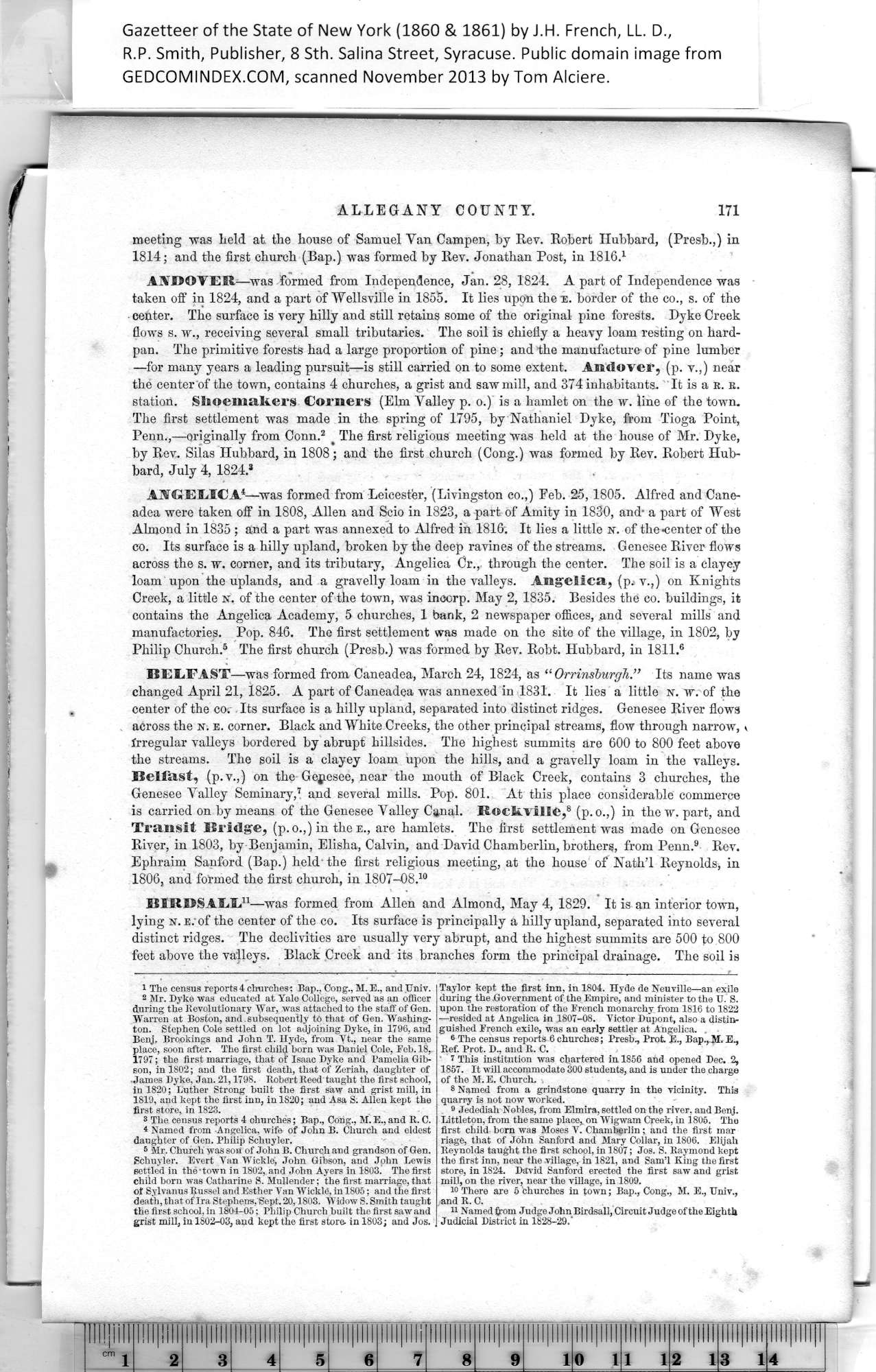|
ALLEGANY COUNTY.
meeting was held at the house of Samuel Yan Campen, by Rev. Robert Hubbard, (Presb.,) in
1814; and the first church (Bap.) was formed by Rev. Jonathan Post, in 1816.1
AIDOVER—was formed from Independence, Jan. 28, 1824. A part of Independence was
taken off in 1824, and a part of Wellsville in 1855. It lies upon the e. border of the co., s. of the
center. The surface is very hilly and still retains some of the original pine forests. Dyke Creek
flows s. w., receiving several small tributaries. The soil is chiefly a heavy loam resting on hard-
pan. The primitive forests had a large proportion of pine; and the manufacture of pine lumber
—for many years a leading pursuit—is still carried on to some extent. Andover, (p. v.,) near
the center of the town, contains 4 churches, a grist and sawmill, and 374 inhabitants. It is a r. r.
station. Shoemakers Corners (Elm Yalley p. o.) is a hamlet on the w. line of the town.
The first settlement was made in the spring of 1795, by Nathaniel Dyke, from Tioga Point,
Penn.,—originally from Conn.2 The first religious meeting was held at the house of Mr. Dyke,
by Rev. Silas Hubbard, in 1808; and the first church (Cong.) was formed by Rev. Robert Hub¬
bard, July 4, 1824.*
AMGEMCA4—was formed from Leicester, (Livingston eo.,) Feb. 25, 1805. Alfred and Cane-
adea were taken off in 1808, Allen and Scio in 1823, a part of Amity in 1830, and* a part of West
Almond in 1835 ; and a part was annexed to Alfred in 1816. It lies a little n. of the-center of the
co. Its surface is a hilly upland, broken by the deep ravines of the streams. Genesee River flows
across the s. w. corner, and its tributary, Angelica Or,, through the center. The soil is a clayey
loam upon the uplands, and a gravelly loam in the valleys. Angelica,, (p. v.,) on Knights
Creek, a little n. of the center of the town, was incorp. May 2, 1835. Besides the co. buildings, it
contains the Angelica Academy, 5 churches, 1 bank, 2 newspaper offices, and several mills and
manufactories. Pop. 846. The first settlement was made on the site of the village, in 1802, by
Philip Church.2 The first church (Presb.) was formed by Rev. Robt. Hubbard, in 1811.3
BELFAST —was formed from Caneadea, March 24, 1824, as “ Orrinsburgh.” Its name was
changed April 21, 1825. A part of Caneadea was annexed in 1831. It lies a little n. w. of the
center of the co. Its surface is a hilly upland, separated into distinct ridges. Genesee River flows
across the n. e. corner. Black and White Creeks, the other principal streams, flow through narrow, -
Irregular valleys bordered by abrupt hillsides. The highest summits are 600 to 800 feet above
the streams. The soil is a clayey loam upon the hills, and a gravelly loam in the valleys.
Belfast, (p.v.,) on the Gepesee, near the mouth of Black Creek, contains 3 churches, the
Genesee Yalley Seminary,7 and several mills. Pop. 801. At this place considerable commerce
is carried on by means of the Genesee Yalley Canal. Rocli.ville,4 (p.o.,) in the w. part, and
Transit Bridge, (p.o.,) in the e., are hamlets. The first settlement was made on Genesee
River, in 1803, by Benjamin, Elisha, Calvin, and David Chamberlin, brothers, from Penn.9 Rev.
Ephraim Sanford (Bap.) held-the first religious meeting, at the house of Nath’l Reynolds, in
1806, and formed the first church, in 1807-08.5
BIRDSALL u—-was formed from Allen and Almond, May 4, 1829. It is an interior town,
lying n. e. of the center of the co. Its surface is principally a hilly upland, separated into several
distinct ridges. The declivities are usually very abrupt, and the highest summits are 500 to 800
feet above the valleys. Black Creek and its branches form the principal drainage. The soil is
|
Taylor kept the first inn, in 1804. Hyde de Neuville—an exile
during the .Government of the Empire, and minister to the U. S.
upon the restoration of the French monarchy from 1816 to 1822
-^resided at Angelica in 1807-08. Victor Dupont, also a distin¬
guished French exile, was an early settler at Angelica.
6 The census reports 6 churches; Presb,, Prot. E., Bap.,M. E.,
Ref. Prot. D., and R. C.
7 This institution was chartered in 1856 and opened Dec. 2,
1857. It will accommodate 300 students, and is under the charge
of the M. E. Church.
8 Named from a grindstone quarry in the vicinity. This
quarry is not now worked.
9 Jedediah Nobles, from Elmira, settled on the river, and Benj.
Littleton, from the same place, on Wigwam Creek, in 1805. Tho
first child bom was Moses V. Chamberlin; and the first mar
riage, that of John Sanford and Mary Collar, in 1806. Elijah
Reynolds taught the first school, in 1807; Jos. S. Raymond kept
the first inn, near the village, in 1821, and SamT King the first
store, in 1824. David Sanford erected the first saw and grist
mill, on the river, near the village, in 1809.
1° There are 5 churches in town; Bap., Cong., M. E., Univ.,
and R. C.
11 Named Rom Judge John Birdsall, Circuit Judge of the Eighth
Judicial District in 1828-29.' |
1
The census reports 4 churches; Bap., Cong., M. E., and Univ.
2
daughter of Gen. Philip Schuyler.
3
Mr. Church was son of John B. Church and grandson of Gen.
4
settled in the town in 1802, and John Ayers in 1803. The first
child born was Catharine 8. Mullender; the first marriage, that
5
death, that of Ira Stephens, Sept. 20,1803. Widow S. Smith taught
the first school, in 1804-05; Philip Church built the first saw and
grist mill, in 1802-03, and kept the first store in 1803; and Jos.
|
